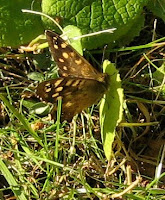 Here is the trap being used last night. I've been trying to find out why moths are attracted to light and the answer seems to be that we don't yet know. This applies to a lot of things, don't you find? This Tuesday, I chaired a discussion of my colleague Alison Benjamin's excellent book A World Without Bees and we seemed to conclude there that bees' homing instinct remains a mystery. One day, maybe, they'll be able to tell us. My own limited observations suggest to me that moths are not attracted by light but thrown into confusion by it. There are two interesting passages in Prof Edmund Ford's masterly Moths (Collins New Naturalist series) and he knows masses about perception wavelengths and the like. He also carried out an experiment which I would much like to have joined. Together with Prof A C Hardy and with the help of the Royal Air Force, he made several balloon ascents at night to assess the effect of the moon on moths. Needless to say the weather didn't co-operate, but the intrepiud profs recorded three moths flying at 1000ft above the ground. Ford thought they didn't try to go all the way to the moon because of pressure in their ear drums. Like tiny divers but in reverse.
Here is the trap being used last night. I've been trying to find out why moths are attracted to light and the answer seems to be that we don't yet know. This applies to a lot of things, don't you find? This Tuesday, I chaired a discussion of my colleague Alison Benjamin's excellent book A World Without Bees and we seemed to conclude there that bees' homing instinct remains a mystery. One day, maybe, they'll be able to tell us. My own limited observations suggest to me that moths are not attracted by light but thrown into confusion by it. There are two interesting passages in Prof Edmund Ford's masterly Moths (Collins New Naturalist series) and he knows masses about perception wavelengths and the like. He also carried out an experiment which I would much like to have joined. Together with Prof A C Hardy and with the help of the Royal Air Force, he made several balloon ascents at night to assess the effect of the moon on moths. Needless to say the weather didn't co-operate, but the intrepiud profs recorded three moths flying at 1000ft above the ground. Ford thought they didn't try to go all the way to the moon because of pressure in their ear drums. Like tiny divers but in reverse.

Lots more moth arrivals meanwhile, including three rather battered old Poplar Hawks. Also this Purple Thorn, with its toenail markings and 'butterfly' habit of folding its wings up above its back. And a Lesser Swallow Prominent, lean, keen-looking moths which remind me of racing cars. Admire my finger.












































